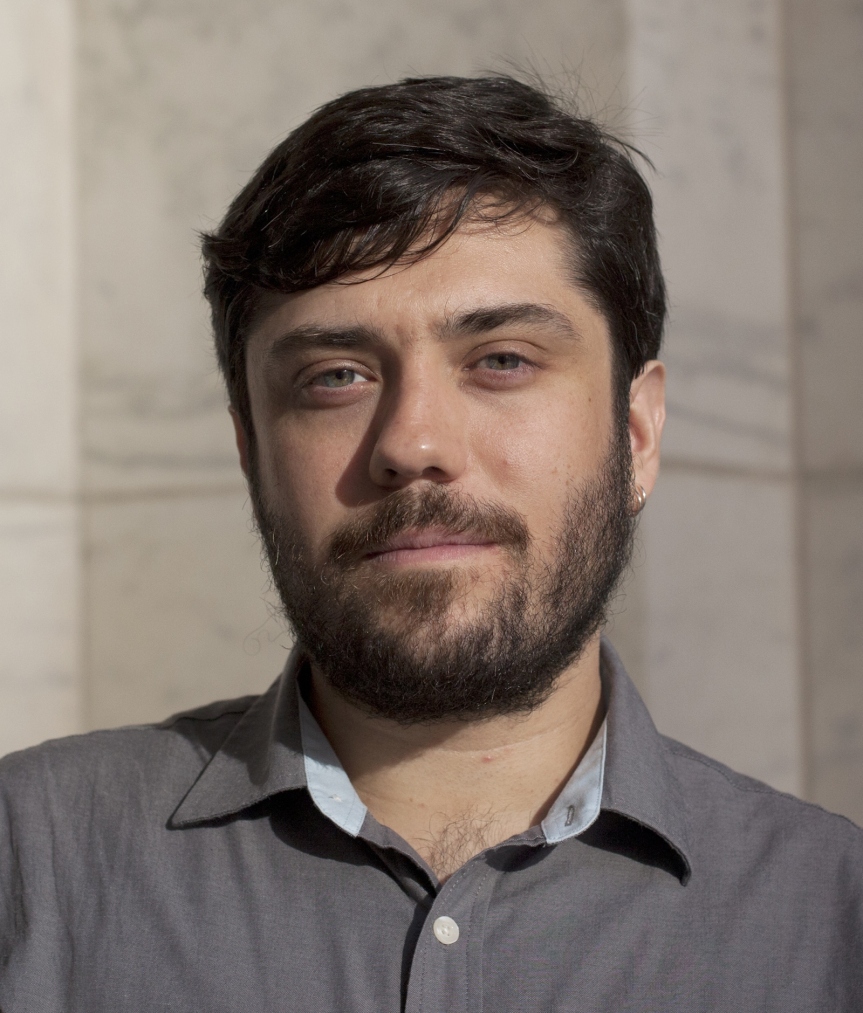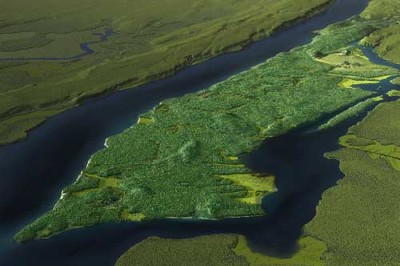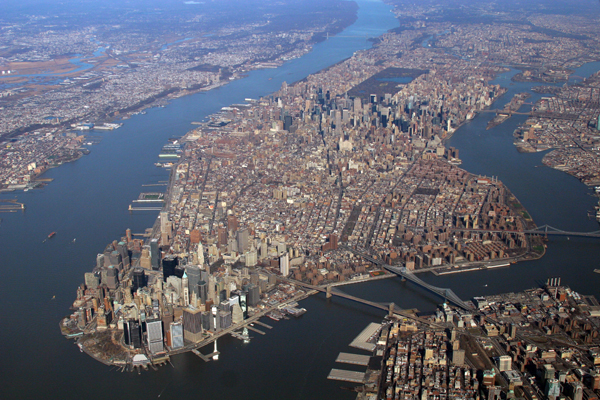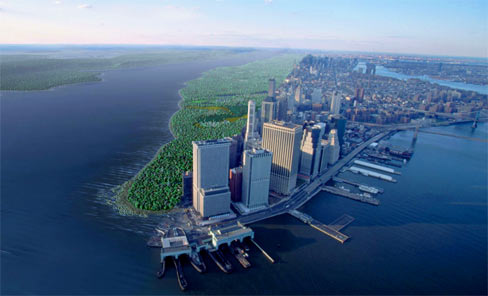This one is a delight — Becky Albertalli (Simon vs the Home Sapien Agenda) and Adam Silvera (They Both Die at the End) each write a character in a fun summer romance set in NYC. The meet cute first meeting, the hunt to find each other later, the bad first dates (x 3!) and of course, all too soon, the end of summer all deliver rich characters, light humor and just a bit of sexual tension. I would have liked the 2 character’s voices to be more distinct; I sometimes had to look at the chapter title to figure out who was speaking. However, this is a solid, adorable, fun relationship-focused romance from 2 writers who’ve captured our imaginations in a sparkling way before.
Tag: new york city
An Interview with 'The Sea Beach Line' author Ben Nadler
April 21, 2016
 Ben Nadler believes that “a writer owes a reader a good story,” and with his excellent new novel The Sea Beach Line, that’s exactly what the Brooklyn-based author delivers. A hypnotic hybrid of literary crime fiction and Jewish folklore, The Sea Beach Line tells the gripping coming-of-age story of Izzy Edel, a young man adrift after being expelled from Oberlin for hallucinogenic drug use. Given renewed purpose after receiving a mysterious postcard from his estranged father Alojzy, Izzy travels to New York City where he must navigate Alojzy’s world of street vendors, gangsters, and members of a religious sect as he searches for his missing dad. Filled with sharp insights on loyalty, self-reliance, and the complicated bonds of family, The Sea Beach Line was described in Library Journal’s starred review as “a mesmerizing narrative that will speak to any readers who have tried to make sense of their parents’ lives or the secrets that people keep.” This Monday, April 25th at 7 pm, you can hear Nadler read from The Sea Beach Line when he visits Bookends & Beginnings as part of an EPL-sponsored event also featuring author Abby Geni. In anticipation of his visit, we recently spoke with him via email about literary traditions, his novel’s origins, the history of Hasidic tales, collective memory, and a few of his favorite books and poems.
Ben Nadler believes that “a writer owes a reader a good story,” and with his excellent new novel The Sea Beach Line, that’s exactly what the Brooklyn-based author delivers. A hypnotic hybrid of literary crime fiction and Jewish folklore, The Sea Beach Line tells the gripping coming-of-age story of Izzy Edel, a young man adrift after being expelled from Oberlin for hallucinogenic drug use. Given renewed purpose after receiving a mysterious postcard from his estranged father Alojzy, Izzy travels to New York City where he must navigate Alojzy’s world of street vendors, gangsters, and members of a religious sect as he searches for his missing dad. Filled with sharp insights on loyalty, self-reliance, and the complicated bonds of family, The Sea Beach Line was described in Library Journal’s starred review as “a mesmerizing narrative that will speak to any readers who have tried to make sense of their parents’ lives or the secrets that people keep.” This Monday, April 25th at 7 pm, you can hear Nadler read from The Sea Beach Line when he visits Bookends & Beginnings as part of an EPL-sponsored event also featuring author Abby Geni. In anticipation of his visit, we recently spoke with him via email about literary traditions, his novel’s origins, the history of Hasidic tales, collective memory, and a few of his favorite books and poems.
Continue reading “An Interview with 'The Sea Beach Line' author Ben Nadler”
Ian Frazier Took Me to New York
February 19, 2010
 My daughter and I flew to New York City last week to visit my ailing sister. For the flight I had picked up Gone to New York, a collection of short non-fiction by the contemporary humorist Ian Frazier. Two-time winner of the James Thurber prize, Ian Frazier is a comic writer with a great heart, just what I needed for this trip. For me, Frazier elicits something richer than belly laughs. “Sink or Swim,” which you can read below in two minutes, is the shortest in the collection, but especially satisfying. In four paragraphs and fewer than forty sentences, Frazier captures a nearly indescribable but unforgettable New York City scene — unique yet quintessential. And to think the whole story revolves around an interlibrary loan request.
My daughter and I flew to New York City last week to visit my ailing sister. For the flight I had picked up Gone to New York, a collection of short non-fiction by the contemporary humorist Ian Frazier. Two-time winner of the James Thurber prize, Ian Frazier is a comic writer with a great heart, just what I needed for this trip. For me, Frazier elicits something richer than belly laughs. “Sink or Swim,” which you can read below in two minutes, is the shortest in the collection, but especially satisfying. In four paragraphs and fewer than forty sentences, Frazier captures a nearly indescribable but unforgettable New York City scene — unique yet quintessential. And to think the whole story revolves around an interlibrary loan request.
–Jeff Balch (Reader’s Services)
———————————————————-
“Sink or Swim,” by Ian Frazier
This story begins in the New York Public Library on Forty-second Street. I was at the interlibrary-loan desk, filling out a form for a book I needed. The librarian saw my Brooklyn address, and he said, “Oh, you live in Park Slope. I live there, too.” I finished with that and then went home and began to load the car. My wife and two-year-old daughter and I were going to visit friends in Vermont. I packed suitcases and toys and presents and books and fishing equipment–wherever we go, we take a lot of stuff. As I was loading, the sky became so dark that the streetlights came on, and all at once it began to pour. My wife and daughter and I set out in the rain. A block from our apartment, as I turned from Eighth Avenue onto Ninth Street, I noticed that torrents of rainwater were running down the street along both curbs. Park Slope does indeed slope, and at the bottom of Ninth, just past Second Avenue, the rainwater had accumulated into a big puddle. Actually, it was more like a lake. My wife said maybe I shouldn’t drive into it, but the minute I hesitated, cars behind me honked. So I went ahead.
A city bus surged in front of me, leaving quite a wake. I followed it and immediately, water came through the floor of the car. Then it came up to the seats. My wife and I were saying various things to each other. As the water began to come over the seats, the engine died. The cars behind me honked. Terrified that I might impede traffic, I leaped out into the waist-deep water. Old tires and forty-ounce malt-liquor bottles were bobbing around beside me. I began to push the car, which was not difficult, because it was floating. I could have pushed it with one hand. I waded, propelling the car before me, until I got it to drier land. Then the car became almost impossible to push. I had to wait for it to drain. The rain had stopped so my wife got out and took our daughter and one or two suitcases, walked up the steps to the Smith Street station, and rode the F train two stops back to our apartment.
I called a garage in my neighborhood, and they sent a tow truck. The driver looked at the engine and said it was probably ruined (he was right–the car never really ran again, and I junked it soon after). Lots of local guys in low-slung shorts gathered around and joined in the autopsy.
The driver towed the car to the garage’s lot and said they couldn’t look at it until after the weekend. He said the lot was not very secure and that I shouldn’t leave anything in the car. I somehow managed to load myself with all our stuff, and as I was walking up the sidewalk, a slow-moving heap of wet suitcases and shopping bags and stuffed animals and fishing rods, I saw coming toward me the librarian from interlibrary loans. I remember the look on his mild face–surprised recognition, changing to mystification tinged with distaste. He didn’t ask, though, and I didn’t explain. Silently, we both accepted the possibility that I was insane and agreed to overlook it. We had a brief conversation about when the book I had ordered might arrive. Then I walked on toward home.
Have You Read . . . ?
September 18, 2009

If the lush green island above looks strangely familiar, that’s because you’ve undoubtedly seen it many times before. Although if you’re having trouble placing just how you know this beautiful wild landscape, that’s because you’re probably used to seeing it look more like this:

Of course you know that the second picture is Manhattan Island as it looks today, the bustling hub of New York City. But the first picture above is the same island, Mannahatta or “Island of Many Hills,” (as it was called by local Native Americans) circa 1609.
For the past ten years the scientific researchers at the Mannahatta Project have been painstakingly recreating what the island would have looked like prior to the arrival of Henry Hudson and his crew on September 12, 1609. When the New World came calling, the island of Mannahatta was an amazingly diverse and abundant natural landscape, with more ecological communities, plant species, and birds than today’s Yellowstone, Yosemite, and Great Smoky Mountains National Parks. In addition to housing numerous large mammals, fish, and other wildlife, the island was also home to the Lenape tribe of people. In the 400 years since Hudson’s arrival, Mannahatta gave way to Manhattan, cultural diversity replaced biodiversity, and economic wealth replaced ecological wealth as the land that once existed was rendered virtually unrecognizable. Until now, that is. Over the past decade, the Mannahatta Project has been digitally rebuilding the land of yesterday by analyzing soil records, geography, rivers and wetlands, maps, descriptions of long disappeared plant and animal life, as well as by studying the landscape of the island today. The project is extensive in its research and astounding in its results.

You can explore the island past and present in extensive detail in the new book Mannahatta: a Natural History of New York City. Inside you’ll find a full explanation of the science behind the project, detailed descriptions of just what the researchers discovered about the island, and a look forward to what Manhattan might look like 400 years from now. All of this is accompanied by numerous stunning illustrations of what the researchers believe Mannahatta to have looked like long ago, as well as amazing side by side comparisons of various spots around the city as they look now and how they would have appeared in 1609.
And for a more distilled and interactive look at the project, check out the very cool Mannahatta Project website. As the project researchers believe, by looking backwards into the past, perhaps we can glimpse a new ecological vision for the future.
